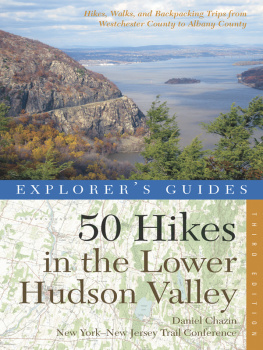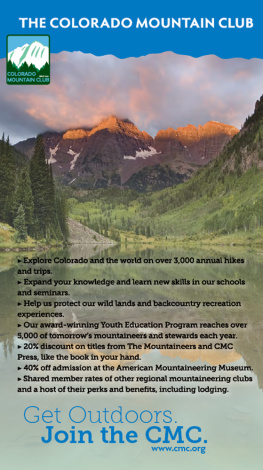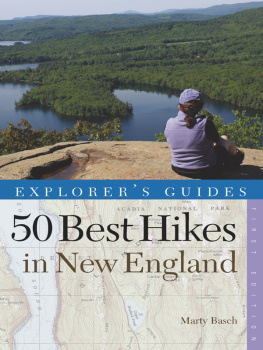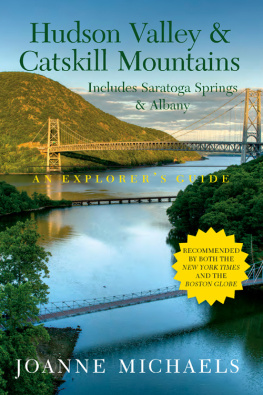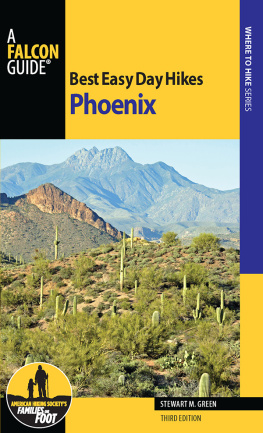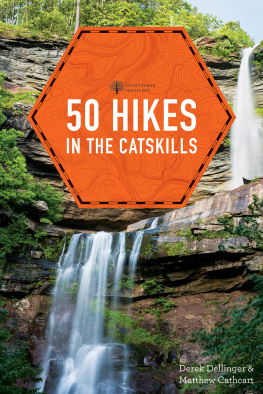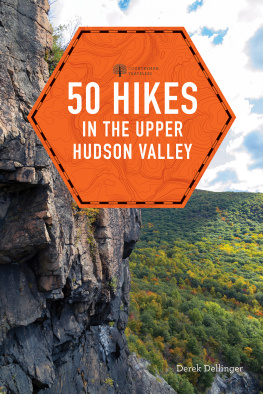

This book is dedicated to those who work so tirelessly to protect and preserve the Hudson Valley.
Thanks go to the Harriman, Rockefeller, Osborn, Perkins, Ogden, Smiley, and Fahnestock families, who assembled, preserved, and often donated great tracts of land to the public, forming the core of our hiking areas. In recent decades, these public open spaces have been significantly augmented by land purchases and easements coordinated by Scenic Hudson and the Open Space Institute. These two organizations have helped preserve over 100,000 acres in our region. Support from the Lila Acheson and DeWitt Wallace Fund for the Hudson Highlands, established by the founders of Readers Digest, also continues to ensure that our beloved Hudson Valley will long remain a prime destination for those of us who treasure and enjoy the great outdoors.
Thanks go to former New York State governor George E. Pataki. During the three terms he served as governor (19952007), he protected 1 million acres of land across New York State, created Sterling Forest and Schunemunk Mountain State Parks, doubled the size of Fahnestock and Minnewaska State Parks, and added more wilderness acres in the Catskill and Adirondack Forest Preserves. These achievements will surely remain a truly notable legacy.
Thanks go to the late William T. Golden, a financier, philanthropist, and science adviser to presidents of the United States, who died in October 2007 at the age of 97. In 1989, Bill purchased Black Rock Forest from Harvard University (which had been given the tract in 1949). The land now belongs to the not-for-profit Black Rock Forest Preserve, which Bill endowed. The preserve leases the forest to the Black Rock Forest Consortium, thus ensuring its continued preservation.
We also wish to thank Barbara McMartin, who spent much of her adult life working tirelessly and effectively to protect New Yorks outdoor legacy and co-wrote this books predecessor, Fifty Hikes in the Hudson Valley.
50 Hikes in the Lower Hudson Valley at a Glance



Contents
The Hudson River is a 350-mile-long corridor of history and a monument to our natural heritage. For part of its length, the Hudson is an estuarya place where seawater blends with fresh water, creating one of the most productive ecosystems on earth. This territory is the spawning ground and nursery for many species of fish, and it supports thousands of acres of tidal wetlands.
Southeastern New York State is dominated by the Hudson River, which flows past the wonders of its cities and industries. At the same time, the river touches some of the states wilder lands, where the hiker can quickly escape the centers of civilization that dot the Hudsons banks. The wilderness at the Hudsons Adirondack headwaters needs no introduction. Some of the wildlands near the Hudsons southern cities are well known, whereas others are almost undiscovered. This guide includes a variety of day hikes that will introduce you to the best of southeastern New Yorks wildlands not far removed from the Hudson.
Settled by Europeans more than 350 years agoand much earlier by Native peoplesthe Hudson Valley has provided generations of Americans with rich farmland and has been a vital source of strength and inspiration for artistic expression in painting, poetry, and literature. The first visitors to the Hudson were mightily impressed by the fortresslike rocks of the Palisades, the rugged Hudson Highlands, and the mysteries of the distant blue Catskills. It is in these rocky hills and mountains bordering the Hudson that most of the hikes described in this guide take place. The book leads you to the northern Palisades, the Ramapos, the Highlands, the isolated lump of Schunemunk, the white cliffs of the Shawangunks, and the high points of the Catskills. It reaches east to the Taconics and north to the fortress of the Helderbergs. It takes you to the tops of this series of ranges, which stand as if designed to give the best possible views of the Hudson and Mohawk Valleys.
THE HISTORY OF THE ROCKS AND MOUNTAINS
The drama of the southeastern New York landscape has a second story in the very rocks themselves. From the resistant limestone of the Helderberg Escarpment to the dissected plateau of the Catskills and the crystalline Hudson Highlands that lie beside the younger folded rocks of the Appalachians, you can see the parts of the puzzle that make up the regions geological history.
The Shawangunks are close to the Taconics in age, although their evolution is more related to that of the Catskills. Extensive sands and quartz-rich gravels were deposited in a shallow sea during the Silurian period, about 450 million years ago. Much later, the resulting sandstones and conglomerates were uplifted and differentially eroded.
The Hudson Highlands to the south are a series of granitic and metamorphic rocks. They were intruded and metamorphosed at great depth more than a billion years ago. Later, during the Taconic orogeny, the rocks were folded, faulted, and uplifted to their present form.
HIKING IN SOUTHEASTERN NEW YORK
This guide offers the hiker an excellent range of opportunities. For residents of southern New York State, the special appeal of most of these trails is their proximity to the New York City metropolitan area. The majority of the trailheads lie within two hours of the city. The area offers many more walks than are described in this book, and references to other hiking guides are given in the bibliography. Social hikers can find many walking groups that offer regularly scheduled trips to help them discover other hikes and prepare for outdoor adventures. The New YorkNew Jersey Trail Conference can put you in touch with many of these groups. Organizations such as the Catskill 3500 Club, the Appalachian Mountain Club, the Sierra Club, and chapters of the Adirondack Mountain Club all offer outing schedules that provide a variety of hikes. Each of these organizationsand most particularly the Trail Conferencealso provides mechanisms for the hiker to return something to the land. With programs of trail maintenance, conservation, planning to prevent overuse, and education to promote wise use, these organizations help protect our wildlands.
Some of the hikes described in this book are not heavily used. Others are, but even here, early spring, winter, and late-fall trips will mix solitude with expanded vistas in ways sure to please any wilderness seeker. Many trails that are crowded on weekends are much less used on weekdays.
Almost all the lands traversed by todays trails were once settled and used by farmers, miners, loggers, and romantics. Their presence inevitably is reflected in the lore that surrounds the trails, and we explore that history as well as the natural scene. Although this guide serves as an invitation to the mountain ranges and valleys of the southern part of the state, it cannot even begin to probe the vast history that enlivens each route. For further information, consult the bibliography at the end of this book.
BEFORE YOU START
Next page
